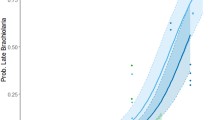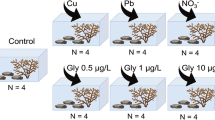Abstract
As a result of increased nutrient levels in the Baltic Sea during thepast 50 years, mass developments of filamentous algae have become a commonfeature along the Swedish east coast and deposition of organic matter has alsoincreased. To test whether these two factors have any effects on the early lifestages of Fucus vesiculosus a number of laboratory andfield studies were conducted. The amount of epilithic and epiphytic filamentousalgae on F. vesiculosus and the amount of deposited matterin the littoral zone were quantified during the two reproductive periods ofF. vesiculosus, early summer (May–June) and lateautumn (September–October). Both filamentous algae (Cladophoraglomerata) and deposited matter (introduced either before or aftersettlement of fertilized eggs) were shown to significantly decrease the numberof surviving germlings. The survival of germlings seeded on stones withfilamentous algae, or seeded on culture dishes concurrently with the lowestconcentration of deposited matter (0.1 g dm−2),was 5% or less. In the field, the amount of filamentous algae was significantlyhigher during F. vesiculosus summer reproduction, whereasthe amount of deposited matter collected in traps was significantly higherduring the period of autumn reproduction. The greatest biomass of filamentousalgae was observed at sheltered sites. Based on the negative effects offilamentous algae and deposited matter on Fucusrecruitmentand the observation of local and seasonal differences in abundance offilamentous algae and deposition, we suggest that the prerequisites for thesurvival of either summer or autumn-reproducing populations of F.vesiculosus in the Baltic Sea may differ locally.
Similar content being viewed by others
References
Andersson S., Kautsky L. and Kautsky N. 1992. Effects of salinity and bromine on zygotes and embryos of Fucus vesiculosus from the Baltic Sea. Mar. Biol. 114: 661-665.
Andersson S., Kautsky L. and Kalvas A. 1994. Circadian and lunar gamete release in Fucus vesiculosus in the atidal Baltic Sea. Mar. Ecol. Prog. Ser. 110: 195-201.
Andersson S. and Kautsky L. 1996. Copper effects on reproductive stages of Baltic Sea Fucus vesiculosus L. Mar. Biol. 125: 171-176.
Bäck S., Collins J.C. and Russell G. 1991. Aspects of the reproductive biology of Fucus vesiculosus from the coast of SW Finland. Ophelia 34: 129-141.
Bäck S. and Ruuskanen A. 2000. Distribution and maximum growth depth of Fucus vesiculosus along the Gulf of Finland. Mar. Biol. 136: 303-307.
Berger R., Malm T. and Kautsky L. 2001. Two reproductive strategies in Baltic Fucus vesiculosus (Phaeophyceae). Eur. J. Phycol. 36: 265-273.
Bergström L., Berger R. and Kautsky L. 2002. Negative direct effects of nutrient enrichment on the establishment of Fucus vesiculosus L. in the Baltic Sea. Eur. J. Phycol. (in press).
Bergström L. and Bergström U. 1999. Species diversity and distribution of aquatic macrophytes in the Northern Quark, Baltic Sea. Nord. J. Bot. 19: 375-383.
Brawley S.H. and Johnson L.E. 1991. Survival of fucoid embryos in the intertidal zone depends upon developmental stage and microhabitat. J. Phycol. 27: 179-186.
Carlsson L. 1991. Seasonal variation in growth, reproduction and nitrogen content of Fucus vesiculosus L. in the Öresund, southern Sweden. Bot. Mar. 34: 447-453.
Creed J.C., Norton T.A. and Kain (Jones) J.M. 1996. Are neighbours harmful or helpful in Fucus vesiculosus populations? Mar. Ecol. Prog. Ser. 133: 191-201.
Devinny J.S. and Volse L.A. 1978. Effects of sediments on the development of Macrocystis pyrifera gametophytes. Mar. Biol. 48: 343-348.
Engkvist R., Malm T. and Tobiasson S. 2000. Density dependent grazing effects of the isopod Idotea baltica Pallas on Fucus vesiculosus L. in the Baltic Sea. Aqua. Ecol. 34: 253-260.
Eriksson B.K., Johansson G. and Snoeijs P. 1998. Long-term changes in the sublittoral zonation of brown algae in the southern Bothnian Sea. Eur. J. Phycol. 33: 241-249.
Haage P. and Jansson B.-O. 1970. Quantitative investigations of the Baltic Fucus belt macrofauna. 1. Quantitative methods. Ophelia 8: 187-195.
Haahtela I. 1984. A hypothesis of the decline of the Bladder Wrack (Fucus vesiculosus L.) in the SW Finland in 1975-1981. Limnologica (Berlin) 15: 345-350.
Hajdu S., Larsson U. and Skärlund K. 1997. Phytoplankton. In: Elmgren R. and Larsson U. (eds), Himmerfjärden. Changes in a nutrient enriched coastal ecosystem. Vol. 4565. Rapport/Naturvårdsverket, Gotab, Stockholm, pp. 63-79.
Hällfors G., Kangas P. and Niemi Å. 1984. Recent changes in the phytal at the south coast of Finland. Ophelia 3: 51-59.
Heiskanen A.-S. and Leppänen J.-M. 1995. Estimation of export production in the coastal Baltic Sea: effect of resuspension and microbial decomposition on sedimentation measurements. Hydrobiologia 316: 211-224.
Heiskanen A.-S. and Tallberg P. 1999. Sedimentation and particulate nutrient dynamics along a coastal gradient from a fjordlike bay to the open sea. Hydrobiologia 393: 127-140.
Juhlin B. 1992. Twenty years of measurements along the Swedish coast (1970-1990). SMHI Oceanography Norrköping Sweden 54: 1-67.
Kangas P., Autio H., Hällfors G., Luther H., Niemi Å. and Salemaa H. 1982. A general model of the decline of Fucus vesiculosus at Tvärminne, south coast of Finland in 1977-81. Acta. Bot. Fennica. 118: 1-27.
Kautsky H. 1989. Quantitative distribution of plant and animal communities of the phytobenthic zone in the Baltic Sea. Contributions from the Askö Laboratory, University of Stockholm, Sweden. No. 35.
Kautsky H. 1991. Influence of eutrophication on the distribution of phytobenthic plant and animal communities. Int. Revue Ges. Hydrobiol. 76: 423-432.
Kautsky H. 1992. The impact of pulp-mill effluents on phytobenthic communities in the Baltic Sea. Ambio 21: 308-313.
Kautsky N. and Evans S. 1987. Role of biodeposition by Mytilus edulis in the circulation of matter and nutrients in a Baltic coastal ecosystem. Mar. Ecol. Prog. Ser. 38: 201-212.
Kautsky N., Kautsky H., Kautsky U. and Waern M. 1986. Decreased depth penetration of Fucus vesiculosus (L.) since the 1940's indicates eutrophication of the Baltic Sea. Mar. Ecol. Prog. Ser. 28: 1-8.
Kiirikki M. 1996. Experimental evidence that Fucus vesiculosus (Phaeophyta) controls filamentous algae by means of the whiplash effect. Eur. J. Phycol. 31: 61-66.
Knight M. and Parke M. 1950. A biological study of Fucus vesiculosus L. and Fucus serratus L. J. Mar. Biol. Assoc. UK 29: 439-501.
Lotze H.K., Worm B. and Sommer U. 2000. Propagule banks, herbivory and nutrient supply control population development and dominance patterns in macroalgal blooms. Oikos 89: 46-58.
Lund-Hansen L.C., Petersson M. and Nurjaya W. 1997. Sediment fluxes, re-suspension and accumulation rates at two wind exposed coastal sites and in a sheltered bay. Estuarine, Coastal and Shelf Science 44: 521-531.
Malm T., Engkvist R. and Kautsky L. 1999. Grazing effects of two freshwater snails on juvenile Fucus vesiculosus in the Baltic Sea. Mar. Ecol. Prog. Ser. 188: 63-71.
Malm T., Kautsky L. and Enkvist R. 2001. Reproduction, recruitment and geographical distribution of Fucus serratus L. in the Baltic Sea. Bot. Mar. 44: 101-108.
Mattsson B. 1999. Salinity effects on different life cycle stages in Baltic and North Sea Fucus vesiculosus L. Ph Lic, Stockholm University, Stockholm, Sweden.
Moss B., Mercer S. and Sheader A. 1973. Factors affecting the distribution of Himanthalia elongata (L.) S.F. Gray on the northeast coast of England. Estuarine and Coastal Marine Science 1: 233-243.
Rosemarin A., Mattsson J., Lehtinen K.-J., Notini M. and Nylén E. 1986. Effects of pulp mill chlorate (ClO3) on Fucus vesiculosus - a summary of projects. Ophelia 4: 219-224.
Salemaa H. 1979. Ecology of Idothea spp. (Isopoda) in the northern Baltic. Ophelia 18: 133-150.
Santelices B. 1990. Patterns of reproduction, dispersal and recruitment in seaweeds. Oceangr. Mar. Biol. Annu. Rev. 28: 177-276.
Schramm W. 1996. The Baltic Sea and its Transition Zones. In: Nienhuis (ed.), Marine Bentic Vegetation. Springer-Verlag, Berlin, Germany.
Serrão E.A. 1996. Reproductive ecology of Fucus vesiculosus L. in the Baltic Sea. PhD Dissertation, University of Maine, Orono, USA.
Serrão E.A., Kautsky L., Lifvergren T. and Brawley S.H. 1996. Gamete dispersal and pre-recruitment mortality in Baltic Fucus vesiculosus. Phycologia Suppl 36: 101-102.
Smetacek V. 1980. Annual sedimentation in relation to phytoplankton ecology in western Kiel Bight. Ophelia 1: 65-76.
Sokal R.R. and Rohlf F.J. 2000. Biometry: the Principles and Practice of Statistics in Biological Research. 3rd edn. WH Freeman and Company, New York, NY, USA.
Vadas R.L., Johnson S. and Norton T.A. 1992. Recruitment and mortality of early post-settlement stages of benthic algae. Br. Phycol. J. 27: 331-351.
Vahteri P., Mäkinen A., Salovius S. and Vuorinen I. 2000. Are drifting algal mats conquering the bottom of the Archipelago Sea, SW Finland? Ambio 29: 338-343.
Viitasalo M., Rosenberg M., Heiskanen A.-S. and Kosi M. 1999. Sedimentation of copepod fecal material in the coastal northern Baltic Sea: Where did all the pellets go? Limnol. Oceanogr. 44: 1388-1399.
Vogt H. and Schramm W. 1991. Conspicuous decline of Fucus in Kiel Bay (western Baltic): what are the causes? Mar. Ecol. Prog. Ser. 69: 189-194.
Voss M. 1991. Content of copepod faecal pellets in relation to food supply in Kiel Bight and its effect on sedimentation rate. Mar. Ecol. Prog. Ser. 75: 217-225.
Wassmann P. 1984. Sedimentation and benthic mineralization of organic detritus in a Norwegian fjord. Mar. Biol. 83: 83-94.
Wikström S., Kautsky L. and Malm T. 2000. The effects of chlorine-free pulp mill effluents on reproduction and grazing interactions in Baltic Sea Fucus vesiculosus L. Ophelia 53: 173-179.
Worm B. and Chapman A.R.O. 1996. Interference competition among two intertidal seaweeds: Chondrusitcrispus strongly affects survival of Fucus evanescens recruits. Mar. Ecol. Prog. Ser. 145: 297-301.
Worm B., Lotze H.K., Boström C., Engkvist R., Labanauskas V. and Sommer U. 1999. Marine diversity shift linked to interactions among grazers, nutrients and propagule banks. Mar. Ecol. Prog. Ser. 185: 309-314.
Worm B., Lotze H.K. and Sommer U. 2000. Coastal food web structure, carbon storage, and nitrogen retention regulated by consumer pressure and nutrient loading. Limnol. Oceanogr. 45: 339-349.
Worm B., Lotze H.K. and Sommer U. 2001. Algal propagule banks modify competition, consumer and resource control on Baltic rocky shores. Oecologia 128: 281-293.
Worm B. and Sommer U. 2000. Rapid direct and indirect effects of a single nutrient pulse in a seaweed-epiphyte-grazer system. Mar. Ecol. Prog. Ser. 202: 283-288.
Author information
Authors and Affiliations
Corresponding author
Rights and permissions
About this article
Cite this article
Berger, R., Henriksson, E., Kautsky, L. et al. Effects of filamentous algae and deposited matter on the survival of Fucus vesiculosus L. germlings in the Baltic Sea. Aquatic Ecology 37, 1–11 (2003). https://doi.org/10.1023/A:1022136900630
Issue Date:
DOI: https://doi.org/10.1023/A:1022136900630




